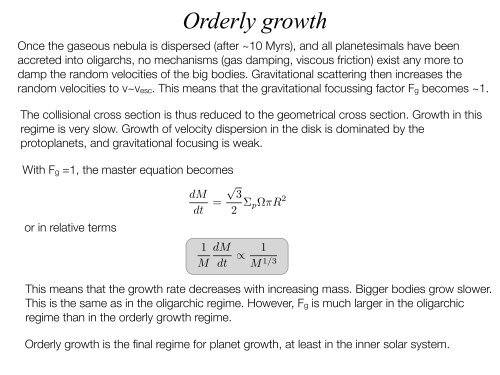L10 From Planetesimals to protoplanets
L10 From Planetesimals to protoplanets
L10 From Planetesimals to protoplanets
You also want an ePaper? Increase the reach of your titles
YUMPU automatically turns print PDFs into web optimized ePapers that Google loves.
Orderly growth<br />
Once the gaseous nebula is dispersed (after ~10 Myrs), and all planetesimals have been<br />
accreted in<strong>to</strong> oligarchs, no mechanisms (gas damping, viscous friction) exist any more <strong>to</strong><br />
damp the random velocities of the big bodies. Gravitational scattering then increases the<br />
random velocities <strong>to</strong> v~vesc. This means that the gravitational focussing fac<strong>to</strong>r Fg becomes ~1.<br />
The collisional cross section is thus reduced <strong>to</strong> the geometrical cross section. Growth in this<br />
regime is very slow. Growth of velocity dispersion in the disk is dominated by the<br />
pro<strong>to</strong>planets, and gravitational focusing is weak.<br />
With Fg =1, the master equation becomes<br />
or in relative terms<br />
This means that the growth rate decreases with increasing mass. Bigger bodies grow slower.<br />
This is the same as in the oligarchic regime. However, Fg is much larger in the oligarchic<br />
regime than in the orderly growth regime.<br />
Orderly growth is the final regime for planet growth, at least in the inner solar system.

















